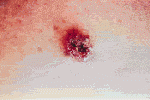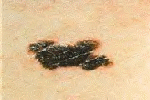
SKIN CANCER UPDATE 07/19/01
CHARLES GRIFF, M.D.
CANCER. Few words in the English language provoke as much fear as the wordcancer. The goal of this article is to educate you on the most common formof cancer in the world; skin cancer. Through this guide to recognition, earlydetection, and prevention, the fear surrounding skin cancer will hopefullybe diminished.
If you are not convinced you're at risk, read on. Over one million Americansare diagnosed with skin cancer each year. Eighty percent or more of all skincancer cases are directly related to overexposure to the sun. Reflectionof the sun's rays off of the water gives boaters at least a twenty percenthigher exposure to harmful ultraviolet radiation. More people have skin cancerthan all other cancers combined. Skin cancer kills over 10,000 Americanseach year - more than one person an hour. If all of these statistics aremaking you think about giving up boating (boat donations gladly acceptedby and for the author), and taking up caving, there is some good news. Onceeducated and aware, one may detect skin cancer at its earliest stages - whenit is completely curable. Even melanoma!
There are three common forms of skin cancer; basal cell carcinoma, squamouscell carcinoma, and malignant melanoma. Boaters, through increased sun exposure,are at higher risk of developing all three types.

Basal Cell
Basal cell carcinoma is the most common type of skin cancer and, fortunately,the least aggressive. There will be close to one million cases of basal cellcarcinoma in the United States in 2001. Although basal cell carcinoma rarelymetastasizes (spreads to other parts of the body) and are slow growing, theycan extend below the skin to the bone and cause considerable damage. Eachyear thousands of individuals may lose eyes, ears, and noses secondary tobasal cell carcinomas. The skin cancer usually appears as a small, slightlyreddish pink translucent bump. Often the cancer will have a slight centraldepression and small superficial blood vessels at the periphery. Untreatedor undetected, the cancer will begin to bleed, crust over, bleed again andcontinue to grow slowly. Fortunately, these lesions are quite easily detectedby a skin care professional - a dermatologist. Once detected, these skincancers can be easily removed and cured through surgery or cautery. Recentadvances include a topical cream that is being investigated that may eliminatemany basal cell carcinomas without surgery.

Squamous Cell
Squamous cell carcinoma is the second most common type of skin cancer. Therewill be roughly 200,000 cases of squamous cell carcinomas in the United Statesin 2001. Unfortunately, several thousand Americans will die this year secondaryto squamous cell carcinoma of the skin. Typically, these cancers are foundon the rim of the ear, nose, face, lips, and the back of the hands. The mostaggressive lesions are found on the lips. Most experts believe that manyof these skin cancers evolve from a precancerous skin lesion called an actinickeratosis. Squamous cell carcinomas usually appear as a raised, rough, scalyred bump. These lesions may develop into large masses and spread to lymphnodes and internal organs if not caught early and treated appropriately.However, when found early and treated properly, usually with local surgery,the cure rate is over 95 percent.

Malignant Melanoma
Malignant melanoma is the third most common type of skin cancer. In 2001,it is estimated that there will be 51,400 new cases diagnosed in the UnitedStates. Almost 8000 Americans will die of melanoma this year - more thanone person an hour. The risk of developing melanoma in 2001 is one in 71.In fact, the incidence of melanoma is rising faster than any other cancer,and it is now the most common cancer in women age 19-29. Enough bad news.With early detection and local surgery it may be cured in over 92 percentof cases. So what do we look for? It is as simple as ABCD. A = asymmetry;B = border irregularity; C = color variance; D = diameter. Any brown spotwhere one half does not match the other half (asymmetry); the edges are ragged,notched or blurred (border irregularity); the pigmentation is not uniformwith shades of tan, brown, or black or any shade of red, white or blue (color);the width is greater than six millimeters, the bottom of a pencil eraser(diameter). It is important to realize that a lesion does not have to beelevated to be a melanoma. In fact, all melanomas probably start out flat.Although the sun plays a significant role in the development of melanoma,it is important to realize that melanoma can develop anywhere on the body- even the palms and soles of the feet. Early detection is critical; followthe ABCD's, do regular monthly self examinations, and see your dermatologistat least once a year. If a melanoma is detected early it may be treated witha simple excision. However, if detected with any delay, a larger surgerywill be necessary including an evaluation of the lymph nodes.
We have learned about the three common types of skin cancer, their detectionand treatment. What more can one do? Prevention! This is especially importantwith boating and sun exposure on the water. Obviously sunblock is critical.However, it is not a simple choice. It is essential to use a sunblockingagent with at least an SPF of 15 or higher. Unfortunately, the SPF reallyonly measures protection from UVB wavelengths and a significant amount ofdamage arises from the UVA wavelength. Active ingredients necessary for adequatebroad spectrum coverage include Parsol 1789, zinc oxide and titanium dioxide.To work effectively, the sunblock must be applied 15-30 minutes prior tosun exposure and re-applied liberally every several hours. In addition tosunblock, a wide brimmed hat is essential - a brim larger than 3 inches isoptimal. Recently many lines of clothing have been introduced that providecomplete sunblock, and there is even a laundry detergent that will make everyday clothing ( average SPF of a T-shirt is 6-8) more protective. If possibleboat early - before 10am or late - after 4pm, and schedule your dermatologistappointment for the midday.
Note: Dr. Griff is a graduate of University of Pennsylvania School of Medicine,and interned at some hot-shot New York Hospital. He's associated with ForestHill Dermatology Associates in West Palm Beach. (561) 964-5800.